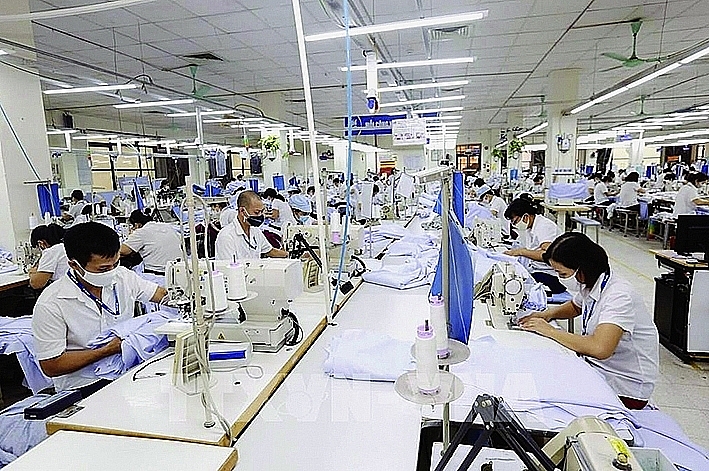 |
| Workers produce textiles at May10 |
Managing to retain workers
According to statistics from the Vietnam Textile and Apparel Association, the rate of absenteeism in the industry is 5-7%. This rate is not large compared to the leather, footwear, and wood industries.
Vu Duc Giang, Chairman of the Vietnam Textile and Apparel Association, affirmed that the textile and garment industry identified labor as the number one asset, more valuable than technological equipment and factories. Therefore, in the context of declining orders, businesses are trying to retain workers.
“There are units that are producing garments that have to accept to make PP bags for supermarkets to have jobs for their workers. Although labor productivity is very low when making this product, businesses want to keep their workers after the economy recovers, especially when the Vietnamese textile and garment industry recovers,” said Giang.
Notably, businesses, including in the export and domestic market, still maintain their stability and have stable labor. For example, at Viet Tien Garment Corporation, revenue from the domestic market this year is expected to reach more than VND1,000 billion, higher than VND850 billion in 2021. Or Yody brand also achieves growth of 18%, reaching nearly VND2,000 billion in the domestic market. Similarly, brands such as May 10, Nha Be, An Phuoc, and X28 are all stable.
Giang assessed that the domestic market was the solution for enterprises to maintain labor policies. Accordingly, many new brands enter the market. For example, 10 Garment Corporation has just launched a series of new brands and opened a series of product introduction stores.
E-commerce is also a solution that businesses have applied effectively in the current situation. In 2021, the proportion of online sales in many businesses was only 7-8%, this year it has increased to 18-20%, notably at Yody brand, this proportion has increased to 50%.
Besides, the textile and garment industry is making efforts to diversify export markets. Currently, countries in the Middle East are a factor promoting export ability.
Giang said that previously, Vietnam had produced knee-length shirts for export to Muslim countries, but the proportion had been low. Since 2021, this number has increased sharply thanks to orders from some countries such as Turkey, Bangladesh, Sri Lanka, and Myanmar. This is possible thanks to Vietnam’s initiative in the source of raw materials.
Efforts to go green
Besides solutions to stabilize labor, the textile and garment industry is promoting plans for greening, sustainable development, and circular economy, digital governance toward long-term growth goals.
Accordingly, the Vietnam Textile and Apparel Association has cooperated with international organizations to build a program of industrial parks for sustainable development and selected Bao Minh Industrial Park (Nam Dinh) as a model industrial park, leading in sustainable development, meeting the requirements of domestic and international investors. Recently, a delegation of the National Assembly of the EU and the UK came to work with the Vietnam Textile and Apparel Association to learn about sustainable development policies for textile products exported to these markets.
Accordingly, sustainable development and digital governance are being evaluated as attractive forces of Vietnam’s textile and garment industry for international customers.
Thanh Cong Textile and Garment Investment Trading JSC (TCM) is one of the enterprises that have made great efforts in greening and sustainable development. Besides developing product lines from recycled and sustainable materials, the company is aiming to use water efficiently and economically by reusing water through a water circulation system.
Regarding wastewater and emissions, TCM has invested in a water treatment system with high technology, ensuring the control of output wastewater meets environmental standards. Besides, TCM is planning to change boiler fuel from coal to biomass or use electric boilers to replace low-power boilers to reduce CO2 emissions into the environment for some factories.
In addition to the efforts of greening and sustainable development, enterprises are boldly switching from outsourcing to FOB (Free One Board – after the order has been completed, the garment factory will contact and bring the product to the dock), ODM (Original Design Manufacturing – production method of textile industry including design stage).
Accordingly, when processing a shirt, enterprises only earn US$1, but if they do FOB, they will earn up to US$5 and ODM will earn US$7. “Enterprises have realized that outsourcing jobs are greatly affected by the reduction of orders this year, so they have switched to be more proactive,” said Giang.
However, to invest in sustainable development and convert from outsourcing to FOB and ODM, businesses need capital. Meanwhile, interest rates in Vietnam are at a high level. Therefore, the Vietnam Textile and Apparel Association recommended that the banking industry consider keeping interest rates stable for industries with large export turnover and high trade surplus and solve a large number of jobs for workers to ensure stability.
